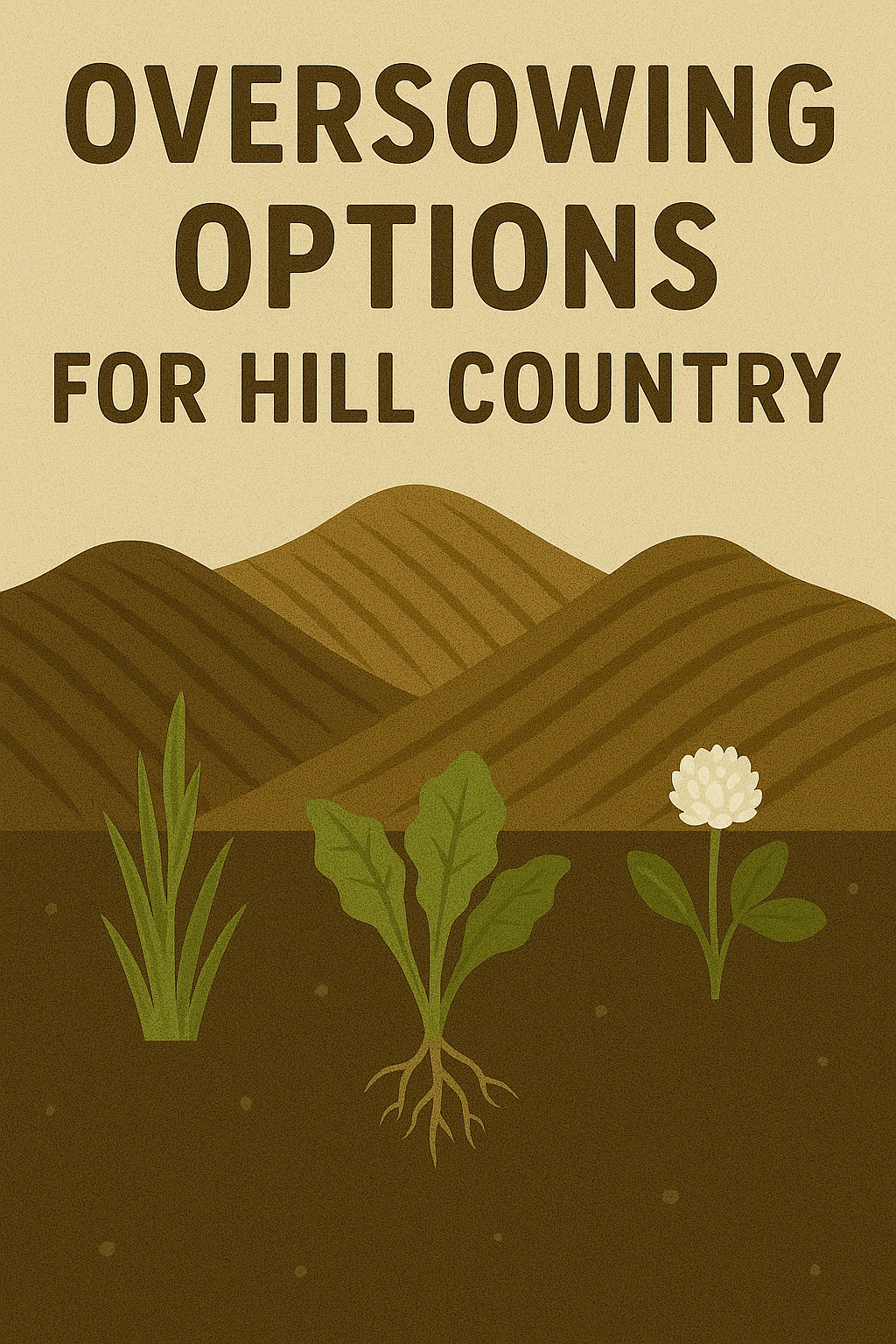
Oversowing Options for Hill Country
Oversowing is an effective and practical way to improve pasture quality and productivity in hill country without the need for full cultivation. This technique allows farmers to introduce beneficial species into existing pastures, increasing diversity, improving feed quality, and enhancing soil health. However, success relies on careful planning, appropriate seed selection, and optimal management practices.
Key Considerations for Hill Country Oversowing
Seed Size and Suitability
Not all seed types are suitable for oversowing, particularly in hill country where conditions are challenging, and seed-to-soil contact can be limited. Large seeds such as peas and maize are not ideal for oversowing, as they require deeper placement to germinate successfully, which is difficult to achieve without cultivation. Smaller seeds, like clovers, plantain, and ryegrass, are better suited as they require minimal soil disturbance to establish.
Seed Coating for Improved Performance
Seed coating is often recommended for oversowing, especially in hill country. Coatings can improve several aspects of seed performance:
-
Spreadability: Coated seeds are heavier and more uniform, allowing for more accurate broadcasting, particularly in windy or uneven terrain.
-
Nutrient Supply: Some coatings include essential nutrients like phosphorus, which support seedling establishment in nutrient-deficient soils.
-
Germination Enhancement: Coatings can include microbial inoculants, such as rhizobia for legumes, to improve nitrogen fixation and early growth.
-
Protection: Coatings can also contain fungicides or other treatments to protect seeds from pests and diseases during establishment.
Species Selection for Hill Country
The choice of species is crucial for oversowing success. Hill country pastures often face challenges such as low fertility, poor moisture retention, and grazing pressure, so selecting species that can thrive under these conditions is essential.
-
Clover Species (e.g., red clover, subterranean clover): Legumes fix nitrogen and improve soil fertility while providing high-quality feed.
-
Plantain and Chicory: These deep-rooted species enhance soil structure and drought tolerance while offering high-value forage.
-
Ryegrass: Hardy ryegrass varieties are reliable options for establishing robust swards in challenging environments.
-
Specialty Grasses: Cocksfoot and tall fescue are resilient species that perform well in lower-fertility soils and under dry conditions.
Seed-to-Soil Contact
One of the most important factors in oversowing success is ensuring good seed-to-soil contact. Without this, germination rates can be significantly reduced. Running livestock over the pasture immediately after broadcasting can help press the seed into the soil surface, improving contact and germination rates. Stock trampling mimics a light rolling effect, which is particularly beneficial on steeper slopes where conventional rolling isn’t feasible.
Best Practices for Successful Oversowing in Hill Country
-
Timing: Oversowing is most effective when timed with suitable soil moisture conditions, such as late summer or early autumn after rain.
-
Pasture Preparation: Grazing the pasture down to a low residual before oversowing minimizes competition from existing vegetation and improves seedling establishment.
-
Fertiliser Application: A soil test can guide fertiliser requirements, ensuring adequate nutrients are available to support new seedlings.
-
Broadcasting Equipment: Use specialised equipment designed for even seed distribution, especially on uneven terrain.
-
Post-Sowing Management: Light grazing during early seedling development can suppress weed competition, but care should be taken to avoid overgrazing young plants.
The Benefits of Hill Country Oversowing
When done correctly, oversowing in hill country can transform underperforming pastures into highly productive systems. By introducing nitrogen-fixing legumes, drought-tolerant species, and deep-rooting plants, farmers can improve pasture resilience, soil health, and livestock performance. Combined with proper species selection, seed coating, and post-sowing management, oversowing provides a cost-effective solution for rejuvenating challenging hill country landscapes.
